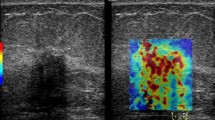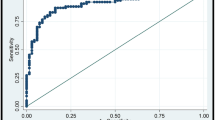Abstract
To compare the mean elasticity value, as measured by shear-wave elastography (SWE), with immunohistochemical profile of invasive breast cancer. This was an institutional review board-approved retrospective study, with a waiver of informed consent. A total of 166 invasive breast cancers in 152 women undergoing preoperative SWE and surgery were included. Quantitative mean elasticity values in kPa were measured for each lesion by using SWE. Medical records were reviewed to determine palpability, invasive size, lymphovascular invasion, histologic grade, and axillary lymph node status. Based on the immunohistochemical profiles, tumor subtypes were categorized as triple-negative (TN), luminal A and B, or human epidermal growth factor receptor 2-enriched cancer. The mean elasticity value was correlated with clinicopathological features using univariate regression models and multivariate linear regression analysis. Palpability (P < 0.0001), larger size (P = 0.013), lymphovascular invasion (P < 0.0001), higher histologic grade (P < 0.0001), and lymph node involvement (P = 0.018) were significantly associated with the mean elasticity value. For the immunohistochemical profiles and tumor subtypes, the estrogen receptor (P = 0.015), progesterone receptor (P = 0.002), Ki-67 (P = 0.009), and the TN (P = 0.009) tumor subtype were correlated with the mean elasticity value. Multivariate logistic regression analysis showed that the following variables were significantly associated with the mean elasticity value: palpable abnormality, histologic grade, and lymphovascular invasion. No immunohistochemical profile of the cancers was independently correlated with the mean elasticity value. For invasive breast cancers, clinicopathological features of poor prognosis showed higher mean elasticity values than those of good prognosis. However, the immunohistochemical profile showed no independent association with the mean elasticity value.



Similar content being viewed by others
References
Weigelt B, Reis-Filho JS (2010) Molecular profiling currently offers no more than tumour morphology and basic immunohistochemistry. Breast Cancer Res 12(Suppl 4):S5. doi:10.1186/bcr2734
Sorlie T, Tibshirani R, Parker J, Hastie T, Marron JS, Nobel A, Deng S, Johnsen H, Pesich R, Geisler S, Demeter J, Perou CM, Lonning PE, Brown PO, Borresen-Dale AL, Botstein D (2003) Repeated observation of breast tumor subtypes in independent gene expression data sets. Proc Natl Acad Sci USA 100:8418–8423. doi:10.1073/pnas.0932692100
Pal SK, Childs BH, Pegram M (2011) Triple negative breast cancer: unmet medical needs. Breast Cancer Res Treat 125:627–636. doi:10.1007/s10549-010-1293-1
Tang P, Skinner KA, Hicks DG (2009) Molecular classification of breast carcinomas by immunohistochemical analysis: are we ready? Diagn Mol Pathol 18:125–132. doi:10.1097/PDM.0b013e31818d107b
Hugh J, Hanson J, Cheang MC, Nielsen TO, Perou CM, Dumontet C, Reed J, Krajewska M, Treilleux I, Rupin M, Magherini E, Mackey J, Martin M, Vogel C (2009) Breast cancer subtypes and response to docetaxel in node-positive breast cancer: use of an immunohistochemical definition in the BCIRG 001 trial. J Clin Oncol 27:1168–1176. doi:10.1200/JCO.2008.18.1024
Park S, Koo JS, Kim MS, Park HS, Lee JS, Lee JS, Kim SI, Park BW (2012) Characteristics and outcomes according to molecular subtypes of breast cancer as classified by a panel of four biomarkers using immunohistochemistry. Breast 21:50–57. doi:10.1016/j.breast.2011.07.008
Cheang MC, Chia SK, Voduc D, Gao D, Leung S, Snider J, Watson M, Davies S, Bernard PS, Parker JS, Perou CM, Ellis MJ, Nielsen TO (2009) Ki67 index, HER2 status, and prognosis of patients with luminal B breast cancer. J Natl Cancer Inst 101:736–750. doi:10.1093/jnci/djp082
Onitilo AA, Engel JM, Greenlee RT, Mukesh BN (2009) Breast cancer subtypes based on ER/PR and Her2 expression: comparison of clinicopathologic features and survival. Clin Med Res 7:4–13. doi:10.3121/cmr.2009.825
Kim SH, Seo BK, Lee J, Kim SJ, Cho KR, Lee KY, Je BK, Kim HY, Kim YS, Lee JH (2008) Correlation of ultrasound findings with histology, tumor grade, and biological markers in breast cancer. Acta Oncol 47:1531–1538. doi:10.1080/02841860801971413
Wang Y, Ikeda DM, Narasimhan B, Longacre TA, Bleicher RJ, Pal S, Jackman RJ, Jeffrey SS (2008) Estrogen receptor-negative invasive breast cancer: imaging features of tumors with and without human epidermal growth factor receptor type 2 overexpression. Radiology 246:367–375. doi:10.1148/radiol.2462070169
Au-Yong IT, Evans AJ, Taneja S, Rakha EA, Green AR, Paish C, Ellis IO (2009) Sonographic correlations with the new molecular classification of invasive breast cancer. Eur Radiol 19:2342–2348. doi:10.1007/s00330-009-1418-2
Ko ES, Lee BH, Kim HA, Noh WC, Kim MS, Lee SA (2010) Triple-negative breast cancer: correlation between imaging and pathological findings. Eur Radiol 20:1111–1117. doi:10.1007/s00330-009-1656-3
Dogan BE, Gonzalez-Angulo AM, Gilcrease M, Dryden MJ, Yang WT (2010) Multimodality imaging of triple receptor-negative tumors with mammography, ultrasound, and MRI. AJR Am J Roentgenol 194:1160–1166. doi:10.2214/AJR.09.2355
Kojima Y, Tsunoda H (2011) Mammography and ultrasound features of triple-negative breast cancer. Breast Cancer 18:146–151. doi:10.1007/s12282-010-0223-8
Shin HJ, Kim HH, Huh MO, Kim MJ, Yi A, Kim H, Son BH, Ahn SH (2011) Correlation between mammographic and sonographic findings and prognostic factors in patients with node-negative invasive breast cancer. Br J Radiol 84:19–30. doi:10.1259/bjr/92960562
Boisserie-Lacroix M, Mac Grogan G, Debled M, Ferron S, Asad-Syed M, Brouste V, Mathoulin-Pelissier S, Hurtevent-Labrot G (2012) Radiological features of triple-negative breast cancers (73 cases). Diagn Interv Imaging 93:183–190. doi:10.1016/j.diii.2012.01.006
Athanasiou A, Tardivon A, Tanter M, Sigal-Zafrani B, Bercoff J, Deffieux T, Gennisson JL, Fink M, Neuenschwander S (2010) Breast lesions: quantitative elastography with supersonic shear imaging–preliminary results. Radiology 256:297–303. doi:10.1148/radiol.10090385
Allred DC, Harvey JM, Berardo M, Clark GM (1998) Prognostic and predictive factors in breast cancer by immunohistochemical analysis. Mod Pathol 11:155–168
Moeder CB, Giltnane JM, Harigopal M, Molinaro A, Robinson A, Gelmon K, Huntsman D, Camp RL, Rimm DL, American Society of Clinical Oncology, College of American Pathologists (2007) Quantitative justification of the change from 10% to 30% for human epidermal growth factor receptor 2 scoring in the American Society of Clinical Oncology/College of American Pathologists guidelines: tumor heterogeneity in breast cancer and its implications for tissue microarray based assessment of outcome. J Clin Oncol 25:5418–5425. doi:10.1200/JCO.2007.12.8033
Evans A, Whelehan P, Thomson K, McLean D, Brauer K, Purdie C, Jordan L, Baker L, Thompson A (2010) Quantitative shear wave ultrasound elastography: initial experience in solid breast masses. Breast Cancer Res 12:R104. doi:10.1186/bcr2787
Tozaki M, Fukuma E (2011) Pattern classification of ShearWave elastography images for differential diagnosis between benign and malignant solid breast masses. Acta Radiol 52:1069–1075. doi:10.1258/ar.2011.110276
Chang JM, Moon WK, Cho N, Yi A, Koo HR, Han W, Noh DY, Moon HG, Kim SJ (2011) Clinical application of shear wave elastography (SWE) in the diagnosis of benign and malignant breast diseases. Breast Cancer Res Treat 129:89–97. doi:10.1007/s10549-011-1627-7
Berg WA, Cosgrove DO, Dore CJ, Schafer FK, Svensson WE, Hooley RJ, Ohlinger R, Mendelson EB, Balu-Maestro C, Locatelli M, Tourasse C, Cavanaugh BC, Juhan V, Stavros AT, Tardivon A, Gay J, Henry JP, Cohen-Bacrie C, Investigators BE (2012) Shear-wave elastography improves the specificity of breast US: the BE1 multinational study of 939 masses. Radiology 262:435–449. doi:10.1148/radiol.11110640
Evans A, Whelehan P, Thomson K, Brauer K, Jordan L, Purdie C, McLean D, Baker L, Vinnicombe S, Thompson A (2012) Differentiating benign from malignant solid breast masses: value of shear wave elastography according to lesion stiffness combined with greyscale ultrasound according to BI-RADS classification. Br J Cancer 107:224–229. doi:10.1038/bjc.2012.253
Cosgrove DO, Berg WA, Dore CJ, Skyba DM, Henry JP, Gay J, Cohen-Bacrie C, Group BES (2012) Shear wave elastography for breast masses is highly reproducible. Eur Radiol 22:1023–1032. doi:10.1007/s00330-011-2340-y
Evans A, Whelehan P, Thomson K, McLean D, Brauer K, Purdie C, Baker L, Jordan L, Rauchhaus P, Thompson A (2012) Invasive breast cancer: relationship between shear-wave elastographic findings and histologic prognostic factors. Radiology 263:673–677. doi:10.1148/radiol.12111317
Harris JR, Lippman ME, Morrow M, Osborne CK (2010) Disease of the breast. Lippincott Williams & Wilkins, Philadelphia
Jeh SK, Kim SH, Kim HS, Kang BJ, Jeong SH, Yim HW, Song BJ (2011) Correlation of the apparent diffusion coefficient value and dynamic magnetic resonance imaging findings with prognostic factors in invasive ductal carcinoma. J Magn Reson Imaging 33:102–109. doi:10.1002/jmri.22400
Krizmanich-Conniff KM, Paramagul C, Patterson SK, Helvie MA, Roubidoux MA, Myles JD, Jiang K, Sabel M (2012) Triple receptor-negative breast cancer: imaging and clinical characteristics. AJR Am J Roentgenol 199:458–464. doi:10.2214/AJR.10.6096
Choi YJ, Seong MH, Choi SH, Kook SH, Kwag HJ, Park YL, Park CH (2011) Ultrasound and clinicopathological characteristics of triple receptor-negative breast cancers. J Breast Cancer 14:119–123. doi:10.4048/jbc.2011.14.2.119
Uematsu T, Kasami M, Yuen S (2009) Triple-negative breast cancer: correlation between MR imaging and pathologic findings. Radiology 250:638–647. doi:10.1148/radiol.2503081054
Youk JH, Son EJ, Chung J, Kim JA, Kim EK (2012) Triple-negative invasive breast cancer on dynamic contrast-enhanced and diffusion-weighted MR imaging: comparison with other breast cancer subtypes. Eur Radiol 22:1724–1734. doi:10.1007/s00330-012-2425-2
Chen ST, Lai HW, Tseng HS, Chen LS, Kuo SJ, Chen DR (2011) Correlation of histologic grade with other clinicopathological parameters, intrinsic subtype, and patients’ clinical outcome in Taiwanese women. Jpn J Clin Oncol 41:1327–1335. doi:10.1093/jjco/hyr157
Rakha EA, Martin S, Lee AH, Morgan D, Pharoah PD, Hodi Z, Macmillan D, Ellis IO (2012) The prognostic significance of lymphovascular invasion in invasive breast carcinoma. Cancer 118:3670–3680. doi:10.1002/cncr.26711
Gajdos C, Tartter PI, Bleiweiss IJ, Hermann G, de Csepel J, Estabrook A, Rademaker AW (2002) Mammographic appearance of nonpalpable breast cancer reflects pathologic characteristics. Ann Surg 235:246–251
Lamb PM, Perry NM, Vinnicombe SJ, Wells CA (2000) Correlation between ultrasound characteristics, mammographic findings and histological grade in patients with invasive ductal carcinoma of the breast. Clin Radiol 55:40–44. doi:10.1053/crad.1999.0333
Watermann DO, Tempfer CB, Hefler LA, Parat C, Stickeler E (2005) Ultrasound criteria for ductal invasive breast cancer are modified by age, tumor size, and axillary lymph node status. Breast Cancer Res Treat 89:127–133. doi:10.1007/s10549-004-1478-6
Martincich L, Deantoni V, Bertotto I, Redana S, Kubatzki F, Sarotto I, Rossi V, Liotti M, Ponzone R, Aglietta M, Regge D, Montemurro F (2012) Correlations between diffusion-weighted imaging and breast cancer biomarkers. Eur Radiol 22:1519–1528. doi:10.1007/s00330-012-2403-8
Acknowledgments
This research was supported by Basic Science Research Program through the National Research Foundation of Korea (NRF) funded by the Ministry of Education, Science and Technology (2011-0007602).
Conflicts of interest
The authors declare that they have no conflicts of interest.
Author information
Authors and Affiliations
Corresponding author
Rights and permissions
About this article
Cite this article
Youk, J.H., Gweon, H.M., Son, E.J. et al. Shear-wave elastography of invasive breast cancer: correlation between quantitative mean elasticity value and immunohistochemical profile. Breast Cancer Res Treat 138, 119–126 (2013). https://doi.org/10.1007/s10549-013-2407-3
Received:
Accepted:
Published:
Issue Date:
DOI: https://doi.org/10.1007/s10549-013-2407-3




